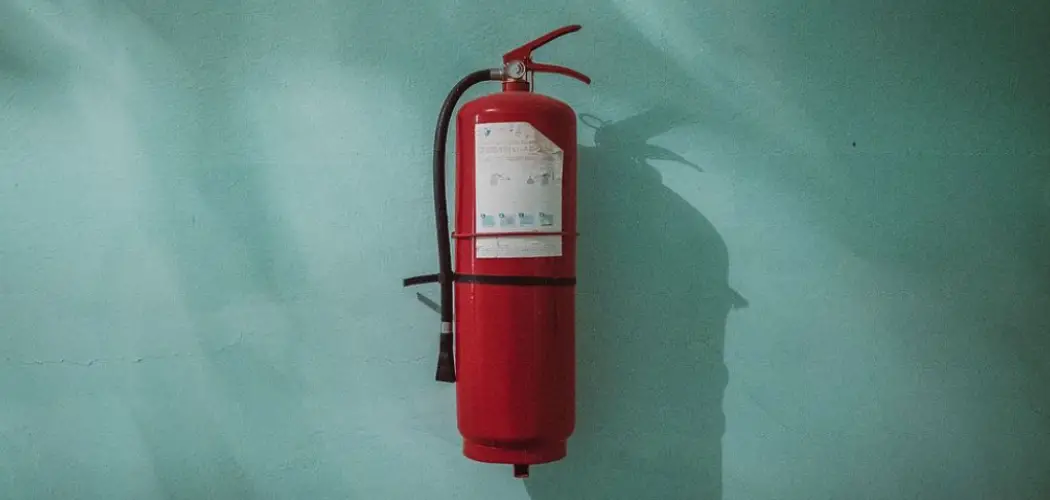Are you prepared to face a fire emergency? A fire extinguisher is an essential tool for fire safety.
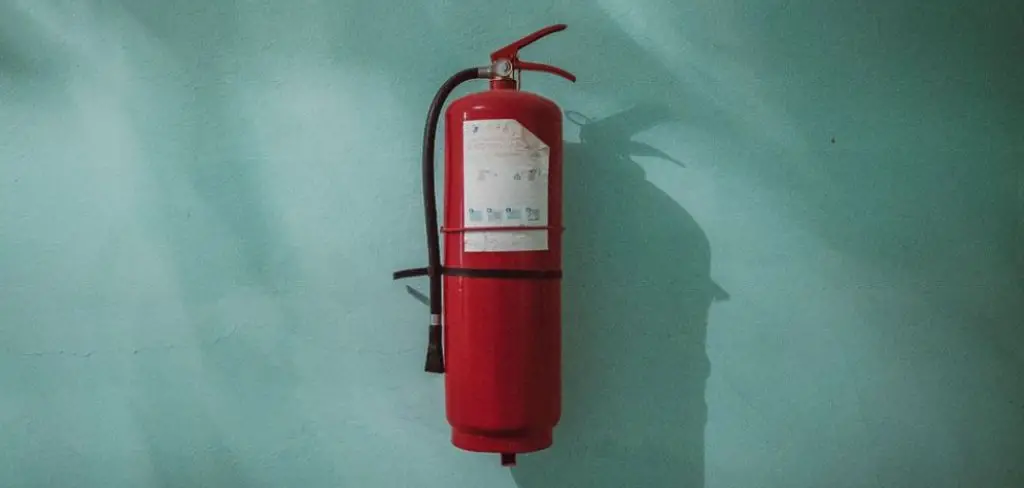
Maintaining a fire extinguisher is not just about ensuring compliance with safety regulations; it’s a crucial practice that can significantly impact the outcome of a fire emergency. Proper care and periodic checks can mean the difference between a minor incident and a catastrophic loss.
This guide aims to walk you through the essential steps on how to maintain fire extinguisher to remain in optimal working condition, ready to act as your first line of defense should a fire break out.
From understanding different types of extinguishers and their maintenance requirements to learning how to perform routine inspections, we’ll cover everything you need to keep your fire extinguisher ready at a moment’s notice.
What are the Benefits of Maintaining your Fire Extinguisher?
Before diving into the maintenance process, it’s crucial to understand why regular upkeep of your fire extinguisher is necessary. Here are some key benefits:
- Ensures proper functionality: A well-maintained extinguisher will operate as intended and effectively put out a fire.
- Increases lifespan: Regular checks and servicing can extend the lifespan of your fire extinguisher, saving you money on replacements.
- Compliance with regulations: Proper maintenance is a legal requirement in many jurisdictions, and failure to comply can result in penalties or fines.
- Peace of mind: Knowing that your fire extinguisher is well-maintained can give you peace of mind and confidence in case of an emergency.
These are just a few reasons why maintaining your fire extinguisher is crucial. Now, let’s explore the steps for maintaining a fire extinguisher.
What Will You Need?
Before starting the maintenance process, gather the necessary tools and materials. Here’s a checklist of what you’ll need:
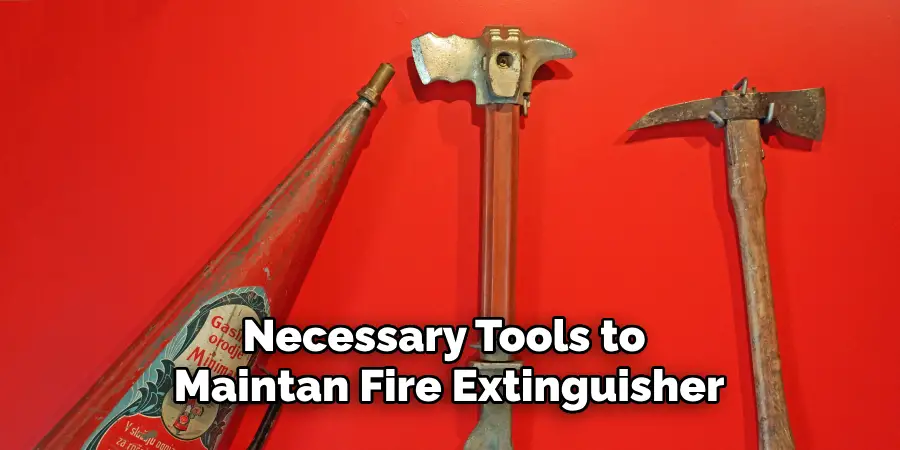
- Fire extinguisher(s)
- Protective gear (gloves, goggles, etc.)
- Soap and water
- Dry cloth or towel
- A pressure gauge (for rechargeable fire extinguishers)
Once you have everything ready, you can begin the maintenance process.
10 Easy Steps on How to Maintain Fire Extinguisher:
Step 1. Visual Inspection:
This is the first and most straightforward step. Every month, visually check your fire extinguisher for any signs of physical damage, such as dents, rust, or leakage. Ensure the safety pin is intact and the tamper seal is unbroken. This step helps identify issues that may affect the extinguisher’s functionality.
Step 2. Check the Pressure Gauge:
Monthly checks of the pressure gauge are critical to ensure the fire extinguisher is ready for use. The pressure should be within the green zone on the gauge, indicating optimal pressure. If the gauge points to the red zone, either too high or too low, it’s a sign that the extinguisher needs professional servicing. This check helps guarantee that the fire extinguisher will work effectively when needed.
Step 3. Ensure Accessibility:
A fire extinguisher can only serve its purpose if it’s easily accessible in times of emergency. Ensure that it is mounted in a visible and reachable location, unobstructed by furniture, equipment, or decorations. Regularly verifying the accessibility of your fire extinguisher not only complies with safety standards but also ensures that it can be quickly accessed when seconds count.
This step involves periodically assessing the extinguisher’s location, ensuring clear signage is present, and making any necessary adjustments to prevent accessibility issues.
Step 4. Clean the Extinguisher:
Regular cleaning of your fire extinguisher is essential to maintain its appearance and functionality. Using a mixture of soap and water, gently wipe the exterior surface to remove dust, grease, or any substances that could cause corrosion over time. Be careful not to damage the labeling or the instruction manual.
After cleaning, dry the extinguisher with a towel or dry cloth. This step helps keep the extinguisher in good condition and prevents any obstructions that may hinder its use.
Step 5. Check the Expiration Date:
Although not all fire extinguishers come with an expiration date, it’s important to know the approximate lifespan of your device. Typically, a fire extinguisher can last between 5 to 15 years, depending on its type and maintenance. However, this doesn’t mean it will work effectively throughout this period without proper care.
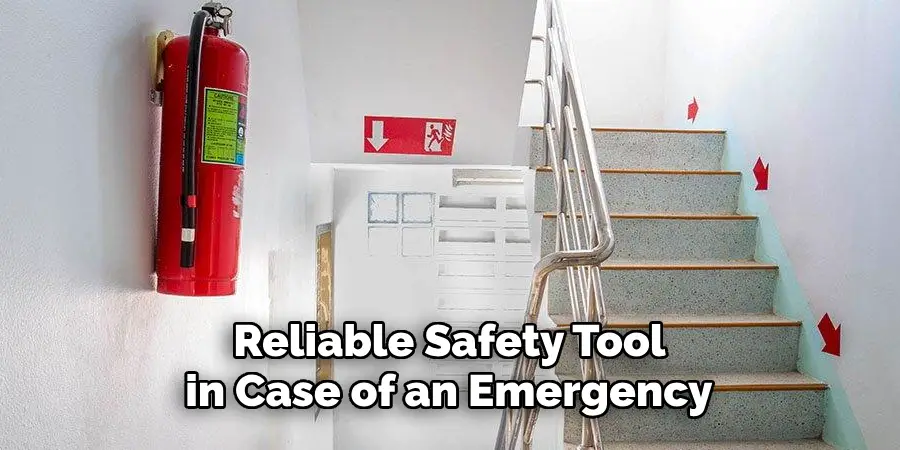
To check the status, look for a manufacturing date or the last service date on the extinguisher. If your fire extinguisher is over 10 years old or hasn’t been serviced in the last year, it’s recommended to have it professionally inspected or replaced. Regularly checking the expiration or service date ensures that your fire extinguisher remains a reliable safety tool in case of an emergency.
Step 6. Check for Corrosion:
Corrosion is a common issue that can affect the functionality of your fire extinguisher. During your monthly visual inspection, check for any signs of corrosion on the exterior or interior surface of the device. If you spot any, it’s best to have the extinguisher professionally inspected and serviced.
Step 7. Inspect the Discharge Nozzle:
The discharge nozzle is a crucial component of the fire extinguisher, as it directs the extinguishing agent toward the fire. It is essential to inspect the nozzle regularly to ensure it is not blocked, damaged, or obstructed in any way. Check for any debris, dust, or insects that might have entered the nozzle.
A clear path is vital for the efficient functioning of the extinguisher when it’s needed most. If any blockage is found, carefully remove the obstructions without damaging the nozzle. Remember, any sign of damage or wear and tear might require the nozzle to be replaced or the entire extinguisher to be serviced by a professional to maintain its operational integrity.
Step 8. Verification of Hose Integrity:
Inspecting the hose or hose assembly is an imperative step in maintaining the effectiveness of your fire extinguisher. Look for any signs of wear, tear, or damage, such as cracks or holes in the hose material. Additionally, ensure the hose is securely attached to the extinguisher and that there are no blockages within the hose itself.
Any damage or obstruction can severely impact the extinguisher’s performance in an emergency situation. If any issues are identified, it is crucial to have them addressed by a professional to ensure the fire extinguisher remains in optimal working condition.
Step 9. Test the Lever or Button:
It is crucial to ensure that the actuation mechanism of your fire extinguisher, whether a lever or button, operates smoothly and efficiently. Without discharging the extinguisher, gently apply pressure to the lever or button to confirm it is not stuck or overly difficult to press. Do not apply too much force that might activate the extinguishing agent.
This test should be done cautiously to avoid accidental discharge. If the mechanism feels stiff, stuck, or shows any sign of malfunction, do not attempt to repair it yourself. Instead, schedule professional servicing as soon as possible to maintain the extinguisher’s readiness for immediate use.
Step 10. Record Maintenance Activity:
It is important to maintain a log of all inspection and maintenance activities carried out on your fire extinguisher. This should include the date of inspection, the condition of the extinguisher, and any servicing or replacement actions taken.
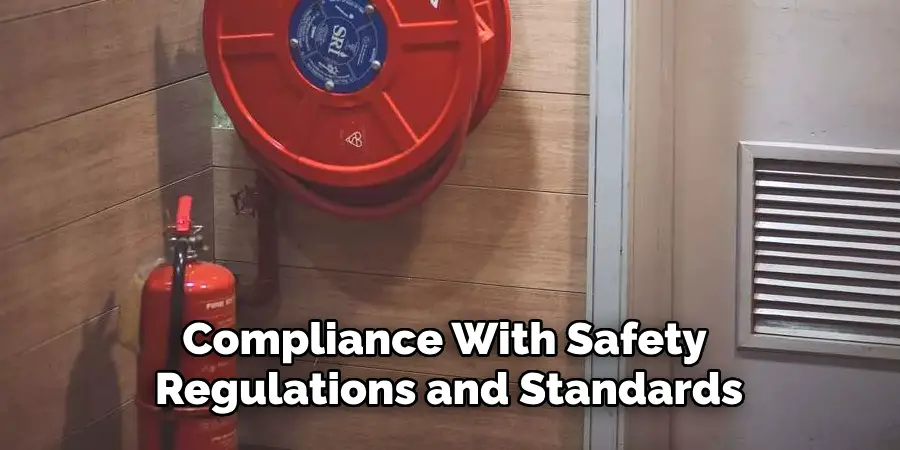
Keeping a detailed record helps track the extinguisher’s health over time and ensures compliance with safety regulations and standards. Documentation can be crucial in identifying patterns of wear or recurring issues, allowing for proactive maintenance and ensuring the fire extinguisher is always in optimal condition for emergency use.
By following these ten steps, you can ensure your fire extinguisher remains in good condition and ready for use at all times.
5 Additional Tips and Tricks
- Regular Inspection: Ensure a monthly inspection of fire extinguishers. Check for any signs of damage, corrosion, leakage, or a clogged nozzle. The pressure gauge should also be checked to make sure it’s in the operable range.
- Accessibility: Always keep fire extinguishers in an easily accessible location, away from potential blockages. They should be mounted on walls at an appropriate height and never covered or obscured from view.
- Service and Maintenance: Schedule an annual maintenance check with a professional. This ensures that the fire extinguisher will work properly in case of an emergency. They can also replenish chemicals or repair parts as needed.
- Training: Make sure individuals in the home or workplace are trained on the proper use of fire extinguishers. Knowing how to use it efficiently can make a significant difference in an emergency situation.
- Replacement: Be aware of your fire extinguisher’s lifespan. Most need to be replaced every 5 to 15 years, depending on the manufacturer’s recommendations. If it’s used, it also needs to be either refilled or replaced, depending on the type.
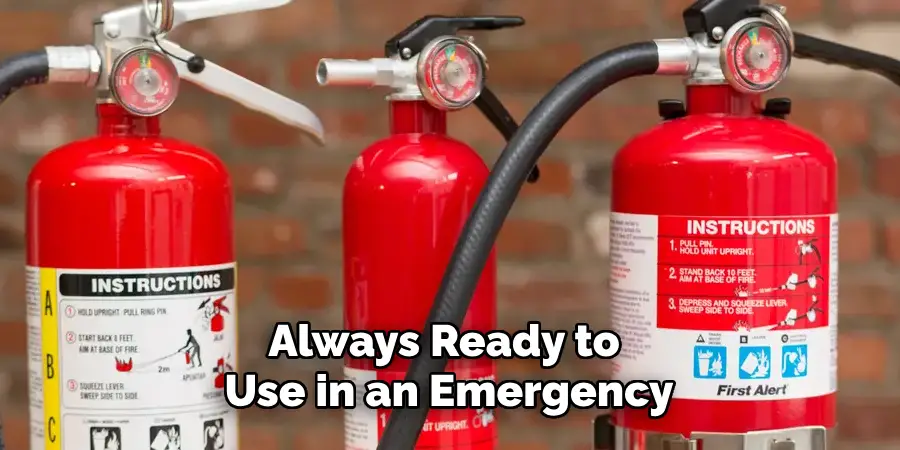
By following these additional tips and tricks, you can ensure that your fire extinguisher is always ready to use in an emergency. It’s important to regularly check, maintain, and train individuals on how to use a fire extinguisher properly.
5 Things You Should Avoid
- Ignoring the Pressure Gauge: Do not neglect the importance of the pressure gauge. It’s essential to regularly check that the pressure is neither too low nor too high, as either extreme can render the fire extinguisher ineffective.
- Improper Handling or Storage: Fire extinguishers should not be stored in extreme temperatures or where they can be knocked down, damaged, or blocked by objects. Improper handling can lead to leakage or failure to operate correctly when needed.
- Using Expired Extinguishers: Relying on an expired fire extinguisher can be hazardous. Chemicals lose their effectiveness over time, and components may wear down, making the extinguisher unreliable in critical situations.
- DIY Maintenance or Repairs: Attempting to perform maintenance or repairs on your fire extinguisher without proper knowledge or training can be dangerous. Always seek professional services for any kind of maintenance or repair work.
- Overlooking Disposal Instructions: Properly disposing of fire extinguishers can be harmful to the environment and may also pose a risk to safety. Always follow local guidelines or manufacturer instructions for safe disposal or recycling of old or used extinguishers.
By avoiding these common mistakes, you can ensure that your fire extinguisher will be in good working condition and ready to use when needed.
Some Frequently Asked Questions
1. How Often Do You Do Maintenance on a Fire Extinguisher?
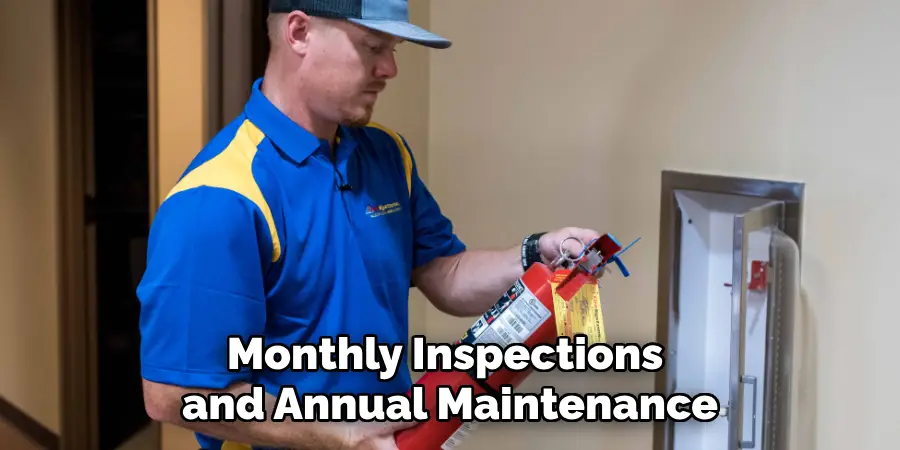
It is recommended that monthly inspections and annual maintenance checks on fire extinguishers be performed. In addition, it’s important to properly train individuals on how to use the extinguisher in case of an emergency. It’s also crucial to follow manufacturer guidelines for replacement or refill of chemicals and disposal of old or used extinguishers.
By regularly maintaining and training your fire extinguisher, you can feel more prepared and confident in handling potential fire emergencies. Remember to always prioritize safety and follow proper procedures when using and maintaining fire extinguishers.
So, be sure to review these tips periodically to keep your knowledge up-to-date and ensure the effectiveness of your fire protection plan.
2. When Should You Replace a Fire Extinguisher?
The lifespan of a fire extinguisher varies depending on the type and manufacturer. It is recommended that they be replaced every 5 to 15 years, even if they have not been used. However, it’s essential to regularly check for any signs of damage or malfunction and immediately replace it if needed. If a fire extinguisher has been used, it should either be refilled or replaced, depending on the type.
It’s better to be cautious and replace an older extinguisher than risk it not working in case of an emergency.

So, make sure to keep track of the age and condition of your fire extinguishers to ensure their effectiveness when needed.
3. What are the Disadvantages of Not Having a Fire Extinguisher?
- Increased Risk of Property Damage: Without a fire extinguisher, small fires can quickly escalate and cause significant damage to your property.
- Greater Safety Risks: A lack of fire extinguishers means that there is no immediate way to combat a fire, putting individuals at risk of injury or even death.
- Higher Insurance Premiums: Not having a fire extinguisher or proper fire safety measures in place may result in higher insurance premiums.
- Legal Consequences: Depending on local regulations, not having a fire extinguisher could lead to legal consequences if it’s deemed necessary for your property.
- Limited Protection: In case of a small fire, without a fire extinguisher, individuals may have to wait for the fire department to arrive, resulting in more significant damage.
Overall, not having a fire extinguisher can pose various risks and consequences. It’s essential to have at least one properly maintained and easily accessible in case of an emergency. So, make sure to follow these tips and prioritize safety by having a functional fire extinguisher in your home or workplace. Remember, it’s always better to be prepared for any situation.
4. What Types of Fire Extinguishers and When Should They Be Used?
- Water: This type of fire extinguisher is suitable for Class A fires that involve ordinary materials such as wood, paper, or cloth.
- Foam: Foam extinguishers are effective against Class A and B fires, which involve flammable liquids such as gasoline or oil.
- Carbon Dioxide: These extinguishers are used for Class B and C fires, which involve flammable gases or electrical equipment.
- Dry Chemical Powder: This type of fire extinguisher is suitable for Class A, B, and C fires and works by smothering the flames.
- Wet Chemical: Used for Class F fires involving cooking oils or fats, this type of extinguisher is typically found in commercial kitchens.
Each fire extinguisher should have a label that indicates the types of fires it can be used for, as well as any safety precautions or limitations. To combat fire effectively, it’s important to understand which type of fire extinguisher is appropriate for different situations. Knowing this information and having the right type of fire extinguisher on hand can greatly increase your chances of successfully putting out a fire.
5. Can Fire Extinguishers Be Refilled?
Yes, fire extinguishers can be refilled if they have been used or are expired. However, it’s essential to get them refilled by a professional service that follows safety guidelines and uses the correct chemicals for each type of extinguisher. It is not recommended to refill or recharge a fire extinguisher on your own, as improper handling could lead to malfunction or potential hazards.
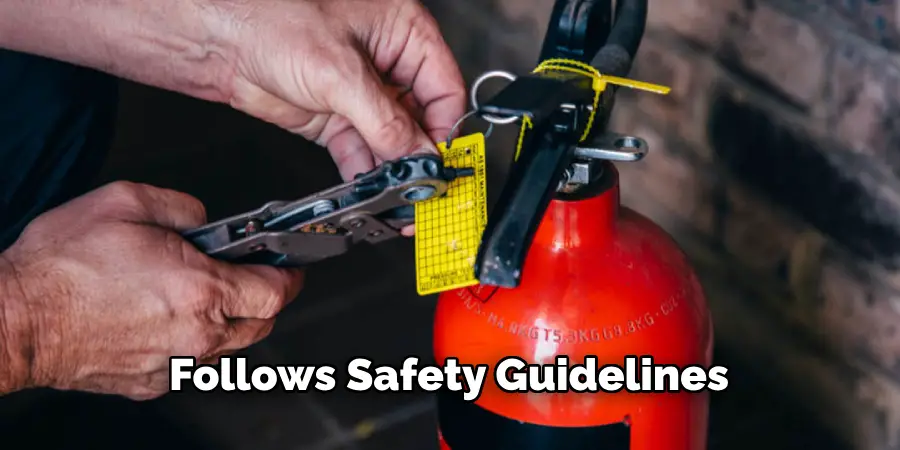
Additionally, some fire extinguishers may not be refillable and will need to be replaced entirely. It’s crucial to check the label or manufacturer guidelines for proper maintenance and refill instructions.
Overall, properly maintaining and refilling fire extinguishers when needed can save money in the long run and ensure your safety in case of a fire emergency. Be sure to follow these tips and regularly check on the condition of your fire extinguishers to keep them in good working condition.
Conclusion
How to maintain fire extinguisher is not just about ensuring it’s ready for use; it’s about safeguarding lives, protecting property, and being prepared for any unforeseen fire emergencies. The key steps include conducting regular monthly inspections, performing annual maintenance checks, understanding when to refill or replace extinguishers, and ensuring proper usage training.
Respect for each device’s lifespan, awareness of the specific types of fire extinguishers and their appropriate applications, and adherence to professional refill protocols are all crucial aspects of effective fire extinguisher maintenance. By following these guidelines, individuals and organizations can ensure they are taking proactive measures to minimize risks and enhance safety.
Remember, a well-maintained fire extinguisher can mean the difference between a minor incident and a devastating fire. Prioritize these safety practices to create a safer environment for everyone.

